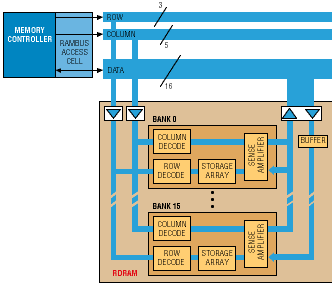Future PC memory standard doubles
bus and specifies modules
A reworked specification for future generations of Rambus-interface RDRAMs was described by Rambus (Mountain View, CA) at the recent Microprocessor Forum in San Jose, CA. The new spec was arrived at with considerable input from Intel engineers, with a view to making it suitable for main memory in PCs a year or so down the road. Intel has announced its intention to incorporate the new standard in future motherboards.
As with previous Rambus memories, Direct RDRAMs, as they are called, interface only with an ASIC cell licensed from Rambus; and controlled impedance, low swing, and defined paths remain from the previous spec (see diagram ). The new spec also describes a standard snap-in module, allowing dealers and users to choose and add memory to a PC just as they do now with SIMMs or DIMMs.

The Direct Rambus DRAM layout transfers 16-byte packets in 10 ns,
with pipelined addressing and transfer.
The data bus has been doubled to 16 bits wide, and the address widened to 8 bits total, on separate lines. A single RDRAM can have up to 32 banks of memory.
The memory subsystem as a whole is now pipelined and packet-ized. The channel frequency is increased from 600 to 800 MHz, reflecting improved technology of the licensed DRAM vendors. The clock signal follows a path identical to all other signals, giving more flexibility for adding memories than the previous spec.
Each packet totals 16 bytes, and transfers in a 10-ns burst. Rambus engineers claim it is possible to keep the data bus filled 95% of the time, depending on the demands of software.
Up to 32 RDRAMs can be connected to one interface cell. Since the RDRAMs will track DRAM process generations, the spec looks to provide headroom for some time to come.
The new spec does not mean that all other DRAM development comes to a halt. Synchronous DRAMs that transfer on both rising and falling clocks are being developed, for example. Also, even though most DRAM suppliers are Rambus licensees, they would no doubt be happy to ship royalty-free silicon if they could.
However, Intel's single vote could well overwhelm all resistance, given the company's dominance of the PC core-logic market. If that happens, other DRAMs will become costly niche devices, with low-volume premiums–like those of graphics RAMs–that will more than swamp the Rambus royalty.
–Rodney Myrvaagnes
Advertisement





